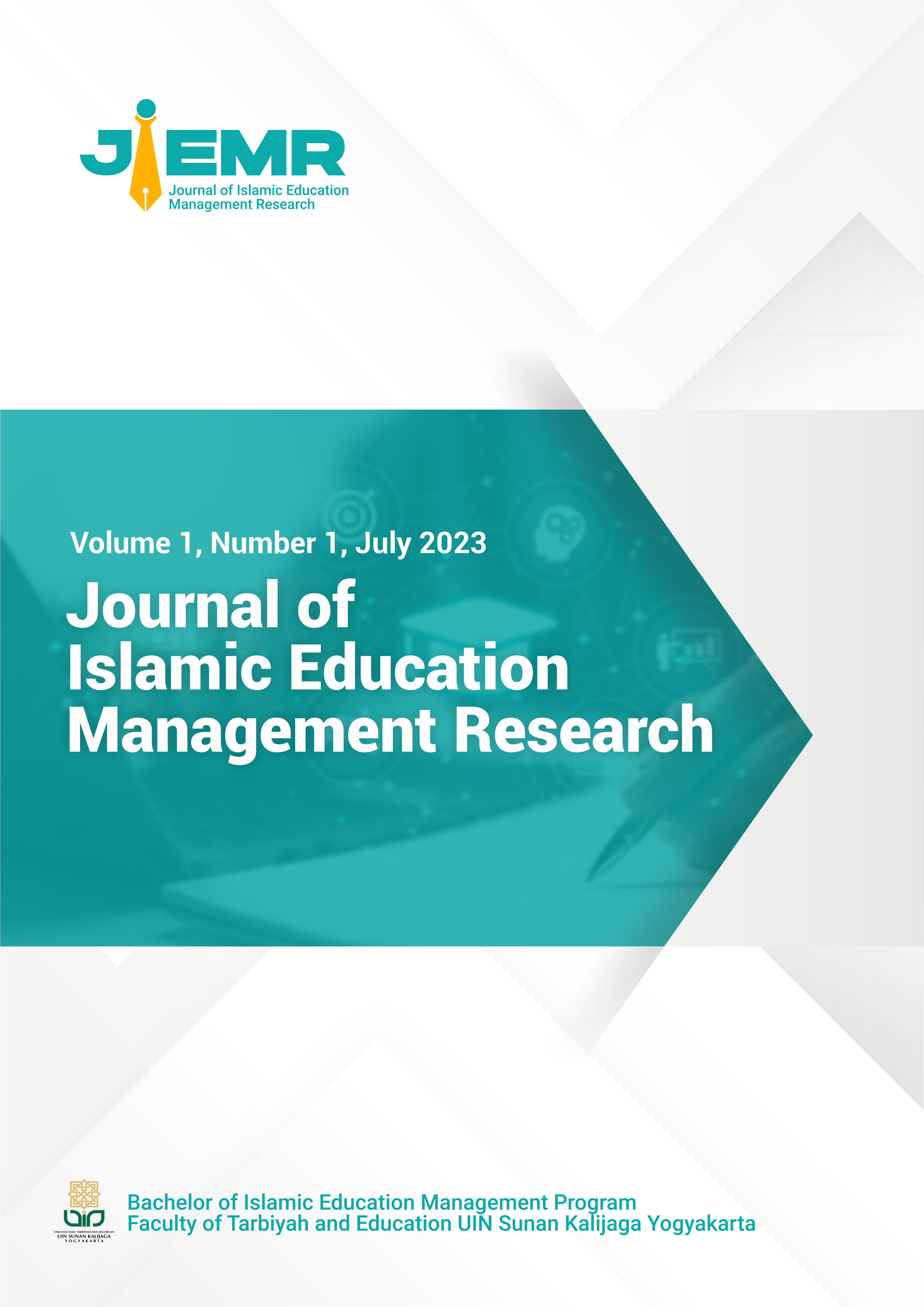Exploring Marketing Mix Strategies in Educational Institutions: A Case Study of Madrasah Ibtidaiyah PUI Kaum Banjarsari Indonesia
DOI:
https://doi.org/10.14421/jiemr.2023.11-02Keywords:
Marketing Mix, Marketing of Education Services, PPDBAbstract
Purpose – This study aims to investigate the marketing mix employed by MI PUI Kaum Banjarsari in the context of educational institutions' marketing activities. Specifically, it examines the application of the standardization of New Student Admissions (PPDB) outlined in the Director General of Islamic Education's Decision Number 7265 of 2019. In a landscape with numerous educational institutions and various strategic models for attracting attention, this research seeks to understand the specific marketing mix utilized by MI PUI Kaum Banjarsari.
Design/methods/approach – Conducted as qualitative-descriptive research, this study employs a field research approach involving observation, interviews with key informants possessing 3M criteria (knowing, understanding, experiencing), and documentation. The validity of the data is ensured through triangulation of sources and techniques, with interactive analysis used to interpret the findings.
Findings – The research reveals that MI PUI Banjarsari Ciamis employs the marketing mix to conduct marketing activities, presenting their institution through the elements of (1) products, (2) price, (3) human resources, (4) location, (5) facilities and infrastructure; (6) process; (7) promotion. Additionally, during PPDB activities, MI PUI Kaum applies five standards to prospective students: (1) objectivity, (2) transparency, (3) accountability, (4) non-discriminatory, and (5) competitive.
Research implications/limitations – The impact of this research extends to educational institutions seeking effective marketing strategies. Rules include the specific context of MI PUI Kaum Banjarsari, impacting the generalizability of the findings.
Practical implications – The findings offer valuable insights for educational institutions aiming to refine their marketing strategies, particularly during the PPDB process. Understanding and implementing the marketing mix elements can enhance the institution's appeal to the public.
Originality/value – This research contributes to the literature by offering a detailed examination of the marketing mix employed by MI PUI Kaum Banjarsari in the competitive landscape of educational institutions. The study's originality lies in its specific focus on the marketing dynamics during PPDB, providing valuable insights for institutions navigating similar challenges.
Downloads
References
Ahmadi, R. (2016). Metode Penelitian Kualitatif. Ar-Ruzz Media.
Anonim. (2020). Keputusan Direktur Jenderal Pendidikan Islam Nomor 7292 Tahun 2020 tentang Petunjuk Teknis Penerimaan Peserta Didik Baru pada Raudhatul Athfal, Madrasah Ibtidaiyah, Madrasah Tsanawiyah, Madrasah Aliyah dan Madrasah Aliyah Kejuruan Tahun Pelajaran 2021./20.
Asdi Sangki, A., Gosal, R., & Kairupan, J. (2017). Penerapan Prinsip Transparansi dan Akuntabilitas dalam Pengelolaan Anggaran Pendapatan dan Belanja Desa. Ejournal Unsrat.
Faizin, I. (2017). Strategi Pemasaran Jasa Pendidikan Dalam Meningkatkan Nilai Jual Madrasah. Madaniyah, 7(2), 83–261.
Fatkul Anwar, D. (2014). Strategi Pemasaran Jasa Pendidikan Dalam Meningkatkan Peminat Layanan Pendidkan Di Madrasah Muallimin Muhammadiyah Yogyakarta. UIN Sunan Kalijaga Yogyakarta.
Ilyas. (2016). Pendidikan Karakter Melalui Homeschooling. Journal of Nonformal Education, 2(1), 94.
Khalis, N. (2018). Akuntabilitas Penyelenggaraan Pendidikan dalam Perspektif Islam. Jurnal Pengembangan Masyarakat Islam, 11(2), 182.
Khasanah, A. (2015). Pemasaran Jasa Pendidikan Sebagai Strategi Peningkatan Mutu Di Sd Alam Baturraden. El-Tarbawi, 8(2), 161–176. https://doi.org/10.20885/tarbawi.vol8.iss2.art4
Labaso, S. (2019). Penerapan Marketing Mix sebagai Strategi Pemasaran Jasa Pendidikan di MAN 1 Yogyakarta. MANAGERIA: Jurnal Manajemen Pendidikan Islam, 3(2), 289–311. https://doi.org/10.14421/manageria.2018.32-05
Machali, I., & Hidayat, A. (2016). The Handbook of Education Management: Teori dan Praktik Pengelolaan Sekolah/Madrasah di Indonesia (2nd ed.). Prenadamedia Grup.
Mamonto, F. W., Tumbuan, W. J. F. A., & H. Rogi, M. (2021). Analisis Faktor-Faktor Bauran Pemasaran (4P) Terhadap Keputusan Pembelian Pada Rumah Makan Podomoro Poigar Di Era Normal Baru. Jurnal EMBA: Jurnal Riset Ekonomi, Manajemen, Bisnis Dan Akuntansi, 9(2), 110–121. https://doi.org/10.35794/emba.v9i2.33281
Mudholkar, G. P., & Kolhe, R. D. (2019). Marketing strategies adopted by private coaching classes in the Marathwada region. International Journal of Recent Technology and Engineering, 8(2 Special Issue 10), 882–886. Scopus. https://doi.org/10.35940/ijrte.B1108.0982S1019
Rahayu, N. (2020). Implementasi Strategi Marketing mix dalam pemasaran jasa pendidikan di TK Negeri 2 Yogyakarta. Jurnal Pendidikan Islam Anak Usia Dini, 2(9), 91–114.
Rohmah, S., Wahyudi, & Pamungkas, F. (2020). Pengelolaan Penerimaan Peserta Didik Baru (PPDB) Berdasarkan Sistem Zonasi di SMP Negeri di SMP Negeri 1 Mlonggo Jepara. Jawda : Journal of Islamic Education Management, 1(1), 26.
Sarifudin, S., & Maya, R. (2019). Implementasi Manajemen Pemasaran Jasa Pendidikan Dalam Meningkatkan Kepuasan Pelanggan Di Madrasah Aliyah Terpadu (Mat) Darul Fallah Bogor. Islamic Management: Jurnal Manajemen Pendidikan Islam, 2(2), 135–154. https://doi.org/10.30868/im.v2i02.513
Setiawan, W., & Sugiharto, S. (2014). Pengaruh Marketing Mix Terhadap Kepuasan Pembelian Toyota Avanza Tipe G Di Surabaya. Jurnal Manajemen Pemasaran, 2(1).
Sugiyono. (2012). Metodologi Penelitian Kuantitatif Kualitatif Dan R&D. Alfabeta.
Tangkilisan, G., & Supandi Soegoto, A. (2014). Bauran Pemasaran Jasa Pendidikan Pengaruhnya Terhadap Keputusan Siswa dalam Memilih Sekolah di SMK N 1 Manado. Jurnal Emba, 2(4), 272.
Wisudawati, T., & Rahmat Rizalmi, S. (2020). Analisis Metode Marketing Mix 7P Sebagai Strategi Pemasaran Produk Daur Ulang. Journal Science Innovation and Technology (SINTECH), 1(1).
Downloads
Published
Issue
Section
License
Copyright (c) 2023 Syahrul Fauzi Hasbi Mahdi, Edy Yusuf Nur Samsu Santosa, Nidaul Fajrin

This work is licensed under a Creative Commons Attribution-NonCommercial-ShareAlike 4.0 International License.
Copyright Notice
Authors who publish with this journal agree to the following terms:
- Authors retain copyright and grant the journal right of first publication with the work simultaneously licensed under a Creative Commons Attribution-ShareAlike 4.0 International License that allows others to copy and redistribute the material in any medium or format with an acknowledgement of the work's authorship and initial publication in this journal and also allows to remix, transform, and build upon the material for any purpose, even commercially with contributions under the same license as the original.
- Authors are able to enter into separate, additional contractual arrangements for the non-exclusive distribution of the journal's published version of the work (e.g., post it to an institutional repository or publish it in a book), with an acknowledgement of its initial publication in this journal.
- Authors are permitted and encouraged to post their work online (e.g., in institutional repositories or on their website) prior to and during the submission process, as it can lead to productive exchanges, as well as earlier and greater citation of published work.









